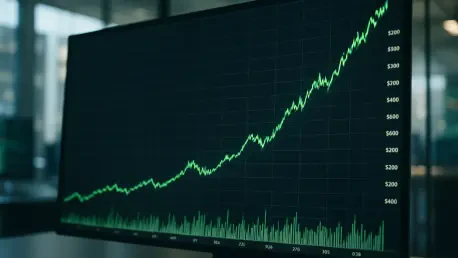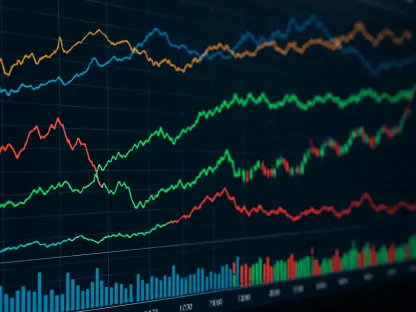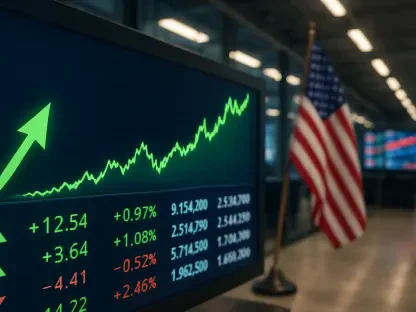What happens when a single policy hint from the Federal Reserve can send global markets into a frenzy and drive gold prices to unprecedented heights? Right now, financial landscapes are shifting under the weight of anticipation, with investors hanging on every word about potential interest rate cuts and trade tariffs stirring the pot. Picture this: stock indices climbing near record levels, gold shimmering at historic peaks, and currencies dancing to the tune of uncertainty. This is the pulse of the market today, a high-stakes game where billions hinge on the Fed’s next play.
Why the Fed and Gold Are Stealing the Spotlight
The significance of this moment cannot be overstated. A potential dovish pivot by the Federal Reserve—favoring lower interest rates—could reshape everything from corporate earnings to consumer borrowing costs worldwide. Coupled with escalating U.S. tariffs impacting global trade, these developments are more than just financial jargon; they directly influence retirement accounts, investment portfolios, and even the price at the grocery store. The surge in gold prices, meanwhile, signals a deeper unease, as investors flock to safe-haven assets amid geopolitical and economic turbulence. Understanding these dynamics is crucial for anyone with a stake in the market.
Unpacking the Fed’s Influence on Market Momentum
At the heart of the current market buzz is the speculation around a softer monetary policy stance from the Federal Reserve. President Trump’s nomination of Stephen Miran, an advocate for rate cuts, to a temporary seat on the Fed’s governing board has fueled optimism for lower borrowing costs in upcoming meetings. Despite uncertainties around ratification, this move is seen as a potential game-changer, with markets already pricing in expectations of monetary easing. Additionally, whispers of Fed Governor Christopher Waller possibly succeeding Chair Jerome Powell in 2026 add another layer of intrigue, hinting at a longer-term shift toward dovish policies.
Global equity markets are reflecting this cautious optimism. The MSCI All-Country index is teasing record highs with a 0.12% daily increase and a robust 2% weekly gain, marking its strongest performance in recent months. Europe’s STOXX 600 and Zurich’s SMI each ticked up 0.25%, shrugging off trade frictions, while Japan’s Nikkei 225 soared 2%, and the Topix index breached 3,000 for the first time. U.S. stock futures also point to gains, suggesting that investors are betting on the Fed’s ability to navigate these choppy waters.
Gold Shines Bright Amid Trade Tensions
While stocks climb, gold is stealing its own share of the limelight, driven by fresh U.S. tariffs on 1-kg gold bars, particularly from Switzerland. Spot gold inched up 0.1% to $3,400 per ounce, but futures exploded 2.3% to a staggering $3,477, a historic peak. This rally isn’t just about numbers; it underscores gold’s timeless role as a refuge during times of uncertainty, especially as trade disputes intensify.
The impact of these tariffs extends beyond commodities, casting a shadow over global trade relations. Yet, there’s a glimmer of hope with U.S. assurances to adjust overlapping duties on Japanese goods to avoid double taxation. This delicate balancing act between protectionism and diplomacy keeps markets on edge, with gold’s ascent reflecting a broader flight to safety among jittery investors.
Currency and Bond Markets Feel the Ripple Effects
Currency markets are also reacting to the unfolding drama, with the U.S. dollar showing mixed strength. It gained 0.1% against the yen to 147.24 and 0.2% on the dollar index to 98.21, while the euro slipped 0.2% to $1.1648 despite a monthly uptick. These fluctuations hint at a cautious stance among traders, who are weighing the Fed’s potential easing against broader economic risks.
In the bond arena, U.S. Treasury yields remained steady, with the 10-year note at 4.2442%. However, weak demand at a recent 30-year bond auction points to lingering doubts about long-term debt appetite. This stability amidst mixed signals illustrates a market grappling with the dual forces of optimism over Fed policy and concern over geopolitical headwinds.
Voices from the Trenches: Expert Takes on the Market
Insights from market experts add depth to the unfolding narrative. Ray Attrill of National Australia Bank observed, “A dovish Fed pivot is igniting risk appetite, though tariff uncertainties keep investors on their toes.” Echoing this sentiment, Tony Sycamore from IG noted, “Gold’s surge is a clear sign of a flight to safety—markets aren’t fully sold on the Fed stabilizing every risk out there.” These perspectives highlight a consensus that while monetary easing could bolster equities, external pressures like trade policies remain wild cards.
The data backs up these views, with the MSCI index’s 2% weekly gain signaling robust investor confidence in risk assets. Yet, gold futures hitting $3,477 tells a parallel story of caution, painting a picture of a market split between hope for policy relief and wariness of unforeseen shocks.
Charting a Path Through Market Uncertainties
For investors navigating this complex terrain, strategic moves are essential. Diversifying into safe-haven assets like gold, especially with futures soaring to $3,477, offers a hedge against potential downturns from tariff escalations or Fed miscalculations. Allocating a portion to precious metals or related ETFs could provide much-needed stability.
Keeping a close watch on Fed developments is equally critical. Updates on Stephen Miran’s nomination and upcoming rate cut discussions could signal buying opportunities in sectors like technology and pharmaceuticals, which have driven gains in indices like the STOXX 600. Additionally, hedging currency risks amid the dollar’s mixed performance—up against the yen but facing a slipping euro—can protect international holdings. Finally, assessing exposure to tariff-impacted regions, such as Japan or Switzerland, and favoring companies with diversified supply chains could mitigate trade-related volatility.
Looking back, the market’s journey through this period of anticipation and volatility revealed a delicate dance between optimism and caution. Investors who adapted by balancing risk with safe-haven assets found opportunities amidst the uncertainty. Moving forward, staying informed on Fed signals and trade policy adjustments remained paramount, ensuring portfolios were poised to weather any storm or seize the next rally. The lesson was clear: in a landscape shaped by policy and geopolitics, agility and foresight were the keys to success.









